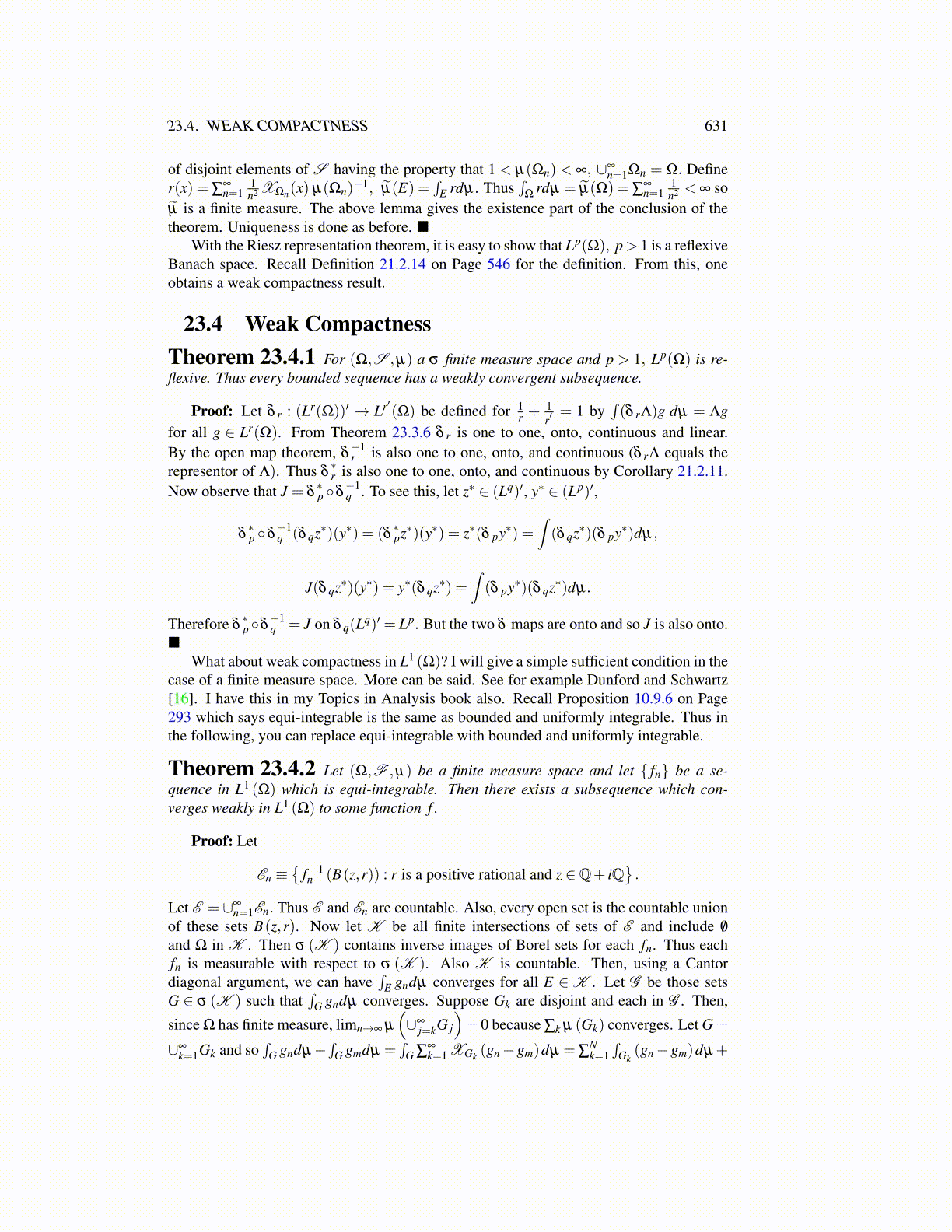
23.4. WEAK COMPACTNESS 631
of disjoint elements of S having the property that 1 < µ(Ωn) < ∞, ∪∞n=1Ωn = Ω. Define
r(x) = ∑∞n=1
1n2 XΩn(x) µ(Ωn)
−1, µ̃(E) =∫
E rdµ . Thus∫
Ωrdµ = µ̃(Ω) = ∑
∞n=1
1n2 < ∞ so
µ̃ is a finite measure. The above lemma gives the existence part of the conclusion of thetheorem. Uniqueness is done as before. ■
With the Riesz representation theorem, it is easy to show that Lp(Ω), p> 1 is a reflexiveBanach space. Recall Definition 21.2.14 on Page 546 for the definition. From this, oneobtains a weak compactness result.
23.4 Weak CompactnessTheorem 23.4.1 For (Ω,S ,µ) a σ finite measure space and p > 1, Lp(Ω) is re-flexive. Thus every bounded sequence has a weakly convergent subsequence.
Proof: Let δ r : (Lr(Ω))′ → Lr′(Ω) be defined for 1r +
1r′= 1 by
∫(δ rΛ)g dµ = Λg
for all g ∈ Lr(Ω). From Theorem 23.3.6 δ r is one to one, onto, continuous and linear.By the open map theorem, δ
−1r is also one to one, onto, and continuous (δ rΛ equals the
representor of Λ). Thus δ∗r is also one to one, onto, and continuous by Corollary 21.2.11.
Now observe that J = δ∗p ◦δ
−1q . To see this, let z∗ ∈ (Lq)′, y∗ ∈ (Lp)′,
δ∗p ◦δ
−1q (δ qz∗)(y∗) = (δ ∗pz∗)(y∗) = z∗(δ py∗) =
∫(δ qz∗)(δ py∗)dµ,
J(δ qz∗)(y∗) = y∗(δ qz∗) =∫(δ py∗)(δ qz∗)dµ .
Therefore δ∗p ◦δ
−1q = J on δ q(Lq)′ = Lp. But the two δ maps are onto and so J is also onto.
■What about weak compactness in L1 (Ω)? I will give a simple sufficient condition in the
case of a finite measure space. More can be said. See for example Dunford and Schwartz[16]. I have this in my Topics in Analysis book also. Recall Proposition 10.9.6 on Page293 which says equi-integrable is the same as bounded and uniformly integrable. Thus inthe following, you can replace equi-integrable with bounded and uniformly integrable.
Theorem 23.4.2 Let (Ω,F ,µ) be a finite measure space and let { fn} be a se-quence in L1 (Ω) which is equi-integrable. Then there exists a subsequence which con-verges weakly in L1 (Ω) to some function f .
Proof: Let
En ≡{
f−1n (B(z,r)) : r is a positive rational and z ∈Q+ iQ
}.
Let E = ∪∞n=1En. Thus E and En are countable. Also, every open set is the countable union
of these sets B(z,r). Now let K be all finite intersections of sets of E and include /0and Ω in K . Then σ (K ) contains inverse images of Borel sets for each fn. Thus eachfn is measurable with respect to σ (K ). Also K is countable. Then, using a Cantordiagonal argument, we can have
∫E gndµ converges for all E ∈K . Let G be those sets
G ∈ σ (K ) such that∫
G gndµ converges. Suppose Gk are disjoint and each in G . Then,
since Ω has finite measure, limn→∞ µ
(∪∞
j=kG j
)= 0 because ∑k µ (Gk) converges. Let G=
∪∞k=1Gk and so
∫G gndµ−
∫G gmdµ =
∫G ∑
∞k=1 XGk (gn−gm)dµ =∑
Nk=1
∫Gk
(gn−gm)dµ+